Review:
George Hawley
Right-Wing Critics of American Conservatism [2]
Lawrence, Kansas: University of Kansas Press, 2016
Most academic studies of White Nationalism and the New Right do not rise above politically correct sneers and smears. They read like ADL or SPLC reports fed through a postmodern buzzword generator. Thus the growing number of serious and balanced academic studies and White Nationalism and the New Right are signs of our rising cultural profile. It is increasingly difficult to dismiss us.
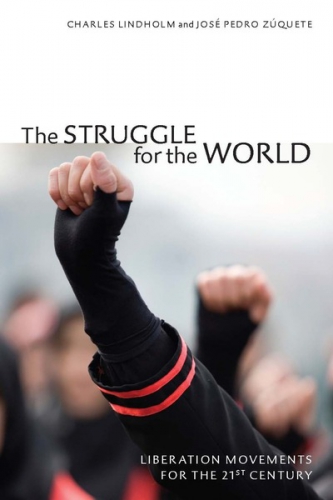 For instance, The Struggle for the World: Liberation Movements for the 21st Century [3]
For instance, The Struggle for the World: Liberation Movements for the 21st Century [3], the 2010 Stanford University Press book on anti-globalization movements by Charles Lindholm and José Pedro Zúquete contains a quite balanced and well-informed chapter on the European New Right. (See Michael O’Meara’s review here [4].) Moreover, Zúquete’s 2007 Syracuse University Press volume Missionary Politics in Contemporary Europe [5]
contains extensive chapters on the French National Front and Italy’s Northern League.
Political scientist George Hawley’s new book Right-Wing Critics of American Conservatism is another important contribution to this literature, devoting a chapter to the European New Right and another chapter to White Nationalism. I’m something of an expert in these fields, and in my judgment, Hawley’s research is deft, thorough, and accurate. His writing is admirably clear, and his analysis is quite penetrating.
Naturally, the first thing I did was flip to the index to look for my own name, and, sure enough, on page 265 I found the following:
In recent years, elements of the radical right in the United States have exhibited greater interest in right-wing ideas from continental Europe. In 2010, the North American New Right was founded by Greg Johnson, the former editor of the Occidental Quarterly. While clearly focused on promoting white nationalism in the United States, the North American New Right is heavily influenced by both Traditionalism and the European New Right, and its website (http://www.counter-currents.com/) regularly includes translations from many European New Right intellectuals. The site also embraces the New Right’s idea of metapolitics, noting that the time will not be right for white nationalists to engage in more conventional political activities until a critical number of intellectuals have been persuaded that their ideas are morally and intellectually correct.
The work of my friends at Arktos in bringing out translations of European New Right thinkers is also mentioned on page 241.
Hawley’s definitions of Right and Left come from Paul Gottfried, although they accord exactly with my own views and those of Jonathan Bowden: the Left treats equality as the highest political value. The Right does not regard equality as the highest political value, although there is a range of opinions about what belongs in that place (pp. 11-12). Libertarians, for instance, regard individual liberty as more important than equality. White Nationalists think that both liberty and equality have some value, but racial health and progress trump them both.
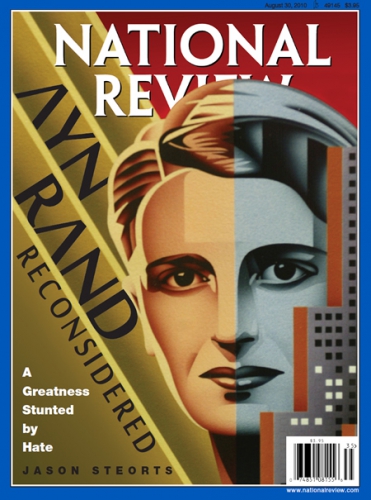 In chapter 1, Hawley argues that modern American conservatism was defined by William F. Buckley and National Review in the 1950s. The conservative movement was a coalition of free market capitalists, Christians, and foreign policy hawks. Hawley points out that based on ideology alone, there is no necessary reason why any of these groups would be Right wing or allied with each other. Indeed, the pre-World War II “Old Right” of people like Albert Jay Nock and H. L. Mencken tended to be anti-interventionist, irreligious, and economically populist and protectionist rather than free market. National Review was also philo-Semitic from the start and increasingly anti-racist, whereas the pre-War American Right had strong racialist and anti-Semitic elements. What unified the National Review coalition was not a common ideology but a common enemy: Communism.
In chapter 1, Hawley argues that modern American conservatism was defined by William F. Buckley and National Review in the 1950s. The conservative movement was a coalition of free market capitalists, Christians, and foreign policy hawks. Hawley points out that based on ideology alone, there is no necessary reason why any of these groups would be Right wing or allied with each other. Indeed, the pre-World War II “Old Right” of people like Albert Jay Nock and H. L. Mencken tended to be anti-interventionist, irreligious, and economically populist and protectionist rather than free market. National Review was also philo-Semitic from the start and increasingly anti-racist, whereas the pre-War American Right had strong racialist and anti-Semitic elements. What unified the National Review coalition was not a common ideology but a common enemy: Communism.
In chapter 2, Hawley also documents the role of social mechanisms like purges in defining post-war conservatism. Buckley set the pattern early on by purging Ayn Rand and the Objectivists (for being irreligious) and the John Birch Society (for being conspiratorial and cranky), going on in later years to purge anti-Semites, immigration restrictionists, anti-interventionists, race realists, etc. The same pattern was followed with the firing of race realists Sam Francis from The Washington Times and Jason Richwine from the Heritage Foundation. Indeed, many of the leading figures in the movements Hawley chronicles were purged from mainstream conservatism.
Mainstream conservatism embraces globalization through free trade, immigration, and military interventionism. Thus Hawley devotes chapter 3, “Small is Beautiful,” to conservative critics of globalization, with discussions of the Southern Agrarians, including Richard Weaver and Wendell Berry, communitarian sociologists Robert Nisbet and Christopher Lasch, and economic localists Wilhelm Röpke and E. F. Schumacher. I spent a good chunk of my 20s reading this kind of literature, as well as the libertarian and paleoconservative writers Hawley discusses in later chapters. Thus Hawley’s book can serve as an introduction and a syllabus to a lot of the Anglophone literature that I traversed before coming to my present views.
The Southern Agrarians are particularly interesting, because of they were the most radical school of American conservatism, offering a genuinely anti-liberal and anti-modernist critique of Americanism, with many parallels to what later emerged from the European New Right. The Agrarians also understood the importance of metapolitics. Unfortunately, they were primarily a literary movement and had no effect on political policy. Although I am not a Southerner, I spent a lot of time reading first generation Agrarians like Allen Tate, Donald Davidson, and John Crowe Ransom, plus Weaver, Berry, and Marion Montgomery, and their influence made me quite receptive to the European New Right.
Christians form an important although subaltern bloc in the conservative coalition, thus Hawley devotes chapter 4 to a brief discussion of “Godless Conservatism,” i.e., attempts to make non-religious cases for conservatism. Secular cases for conservatism will only become more important as Christianity continues to decline in America. (Hawley deals with neopagan and Traditionalist alternatives to Christianity in his chapter on the European New Right.)
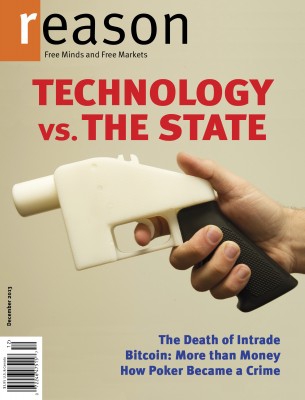 Chapter 5, “Ready for Prime Time?” is devoted to mainstream libertarianism, including Milton Friedman, the Koch Brothers, the Cato Institute, Reason magazine, the Ron Paul movement, and libertarian youth organizations. Chapter 6, “Enemies of the State,” deals with more radical strands of libertarianism, including 19th-century American anarchists like Josiah Warren and Lysander Spooner, the Austrian School of economics, Murray Rothbard, Hans-Hermann Hoppe, Lew Rockwell, the Mises Institute, and the Libertarian Party. Again, Hawley has read widely with an unfailing eye for essentials.
Chapter 5, “Ready for Prime Time?” is devoted to mainstream libertarianism, including Milton Friedman, the Koch Brothers, the Cato Institute, Reason magazine, the Ron Paul movement, and libertarian youth organizations. Chapter 6, “Enemies of the State,” deals with more radical strands of libertarianism, including 19th-century American anarchists like Josiah Warren and Lysander Spooner, the Austrian School of economics, Murray Rothbard, Hans-Hermann Hoppe, Lew Rockwell, the Mises Institute, and the Libertarian Party. Again, Hawley has read widely with an unfailing eye for essentials.
I went through a libertarian phase in my teens and 20s, and I understand from the inside how someone can move from libertarian individualism to racial nationalism. In 2009, when I was editor of The Occidental Quarterly, I sensed that the Ron Paul and Tea Party movements would eventually send many disillusioned libertarians in the direction of White Nationalism. Thus, to encourage our best minds to think through this connection and develop arguments that might aid the conversion process, TOQ sponsored an essay contest on Libertarianism and Racial Nationalism [6]. Since 2012, this trend has markedly accelerated. Thus I highly recommend Hawley’s chapters to White Nationalists who lack a libertarian background and wish to understand this increasingly important “post-libertarian” strand of the Alternative Right.
Chapter 7, “Nostalgia as a Political Platform,” deals with the paleoconservative movement, covering its debts to the pre-War Old Right, M. E. Bradford, Patrick Buchanan, Thomas Fleming and Chronicles magazine, Sam Francis, Joe Sobran, the paleo-libertarian moment, and Paul Gottfried.
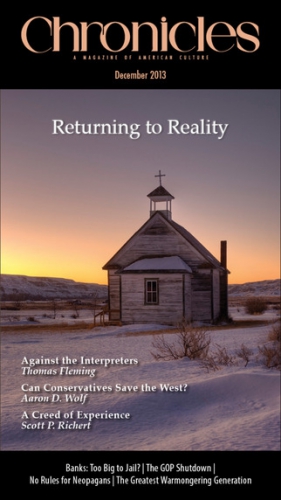 Paleoconservatism is defined in opposition to neoconservatism, the largely Jewish intellectual movement that largely took over mainstream conservatism by the 1980s, aided by William F. Buckley who dutifully purged their opponents. Since the neoconservatives are largely Jewish, and many of the founders were ex-Marxists or Cold War liberals, their ascendancy has meant the subordination of Christian conservatives and free marketeers to the hawkish interventionist wing of the movement. Now that the Cold War is over, the primary concern of neoconservative hawks is tricking Americans into fighting wars for Israel.
Paleoconservatism is defined in opposition to neoconservatism, the largely Jewish intellectual movement that largely took over mainstream conservatism by the 1980s, aided by William F. Buckley who dutifully purged their opponents. Since the neoconservatives are largely Jewish, and many of the founders were ex-Marxists or Cold War liberals, their ascendancy has meant the subordination of Christian conservatives and free marketeers to the hawkish interventionist wing of the movement. Now that the Cold War is over, the primary concern of neoconservative hawks is tricking Americans into fighting wars for Israel.
Paleoconservatives, by contrast, are actually conservatives. They are defenders of Western civilization and its moral traditions. Many of them are Christians, but not all of them. To a man, they reject multiculturalism and open borders. They are populist-nationalist opponents of economic globalization and political empire-building. Most of them are realists about racial differences.
The paleocons, therefore, are the movement that is intellectually closest to White Nationalism. Indeed, Sam Francis is now seen as a founding figure in contemporary White Nationalism, and both Gottfried and Sobran have spoken at White Nationalist events. Paleoconservatives were also the first Americans to pay sympathetic attention to the European New Right. Thus it makes sense that Hawley places his chapter on paleoconservatism before his chapters on the European New Right and White Nationalism.
Hawley is right that paleoconservatism is basically a spent force. Its leading figures are dead or elderly. Aside from Patrick Buchanan, the movement never had access to the mainstream media and publishers. Unlike mainstream conservative and neoconservative institutions, the paleocons never had large donors and foundations on their side. Beyond that, there is no next generation of paleocons. Instead, their torch is being carried forward by White Nationalists or the more nebulously defined “Alternative Right.”
Chapter 8, “Against Capitalism, Christianity, and America,” surveys the European New Right, beginning with the Conservative Revolutionaries Oswald Spengler, Ernst Jünger, and Arthur Moeller van den Bruck; the Traditionalism of René Guénon and Julius Evola; and finally the New Right proper of Alain de Benoist, Guillaume Faye, and Alexander Dugin.
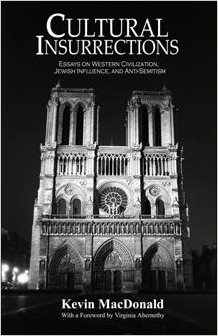 Chapter 9, “Voices of the Radical Right,” covers White Nationalism in America, with discussions of progressive era racialists like Madison Grant and Lothrop Stoddard; contemporary race realism; the rise and decline of such organizations as the KKK, American Nazi Party, Aryans Nations, and the National Alliance; the world of online White Nationalism; and Kevin MacDonald’s work on the Jewish question — which brings us up to where we started, namely the task of forging a North American New Right.
Chapter 9, “Voices of the Radical Right,” covers White Nationalism in America, with discussions of progressive era racialists like Madison Grant and Lothrop Stoddard; contemporary race realism; the rise and decline of such organizations as the KKK, American Nazi Party, Aryans Nations, and the National Alliance; the world of online White Nationalism; and Kevin MacDonald’s work on the Jewish question — which brings us up to where we started, namely the task of forging a North American New Right.
Hawley’s concluding chapter 10 deals with “The Crisis of Conservatism.” Neoconservatism has, of course, been largely discredited by the debacle in Iraq. Since the Republicans are the de facto party of whites, especially white Christians with families, the deeper and more systemic challenges to the conservative coalition include the decline of Christianity in America, the decline of marriage and the family, and especially the growing non-white population, which overwhelmingly supports progressive policies. The conservative electorate is shrinking, and if it continues to decline, it will eventually be impossible for Republicans to be elected, which means the end of conservative political policies.
There is, however, a deeper cause of the crisis of conservatism. The decline of the family and the growth of the non-white electorate are the predictable results of government policies — policies that conservatives did not resist and that they will not try to roll back, ultimately because conservatives are more committed to classical liberal principles than the preservation of their own political power, which can only be secured by “collectivist,” indeed “racist” measures to preserve the white majority. Conservatives will conserve nothing [7] until they get over their ideological commitment to liberal individualism.
Hawley predicts that as the conservative movement breaks down, some Americans will turn toward more radical Right-wing ideologies, leading to greater political polarization and instability. Of the ideologies Hawley surveys, he thinks the localists, secularists, libertarian anarchists, paleocons, and European New Rightists have the least political potential. Hawley thinks that the moderate libertarians have the most political potential, largely because they are closest to the existing Republican Party. Unfortunately, libertarian radical individualism would only accelerate the decline of the family, Christianity, and the white electorate.
Of all the movements Hawley surveys, only White Nationalism would address the causes of the decline of the white family and the white electorate. But Hawley thinks that White Nationalism faces immense challenges, although the continued decline of the conservative movement might also present us with great opportunities:
Explicit white nationalism is surely the most aggressively marginalized ideology discussed here. As we have seen, advocating racism is perhaps the fastest way for a politician, pundit, or public intellectual to find himself or herself a social pariah. That being the case, there is little chance that transparent white racism will again become a major political force in the United States in the immediate future. However, the fact that antiracists on the right and left are extraordinarily vigilant in their effort to drive racists from public discourse can be viewed as evidence that they believe such views could once again have a large constituency, should racists ever again be allowed to reenter the mainstream public debate. Whether their fears in this regard are justified is impossible to determine at this time. What we should remember, however, is that the marginalization of the racist right in America was largely possible thanks to cooperation from the mainstream conservative movement, which has frequently jettisoned people from its ranks for openly expressing racist views. If the mainstream conservative movement loses its status as the gatekeeper on the right, white nationalism may be among the greatest beneficiaries, though even in this case it will face serious challenges. (p. 291)
Right-Wing Critics of American Conservatism is an important academic study, but it has a significant oversight. The meteoric rise of Donald Trump illustrates the power of another Right-wing alternative to American conservatism, namely populism. Populism is a genuinely Right-wing movement, because although it is critical of economic and political inequality as threats to the integrity of the body politic, populism is nationalistic. It does not regard citizens and foreigners as of equal worth.
I also noticed a couple of smaller mistakes. F. A. Hayek is twice referred to as a Jew, which is false, and on page 40 Hawley refers to Young Americans for Liberty when he means Young Americans for Freedom. Hawley uses the repulsive euphemism “undocumented immigrant” and repeatedly uses the word “vicious” to describe ideas he dislikes, but as a whole his book is relatively free of the tendentious jargon of liberal academics.
I highly recommend Right-Wing Critics of American Conservatism [2]. Hawley is clearly not a friend of conservatism or White Nationalism. He’s something far more useful: a frank and fair-minded critic. Conservatives, of course, lack the capacity for self-criticism and self-preservation. So they will ignore him, to their detriment. But White Nationalists will read him and profit from it.



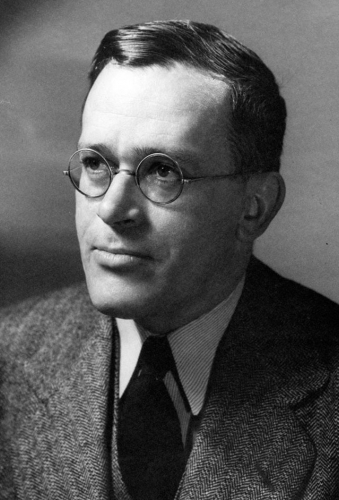
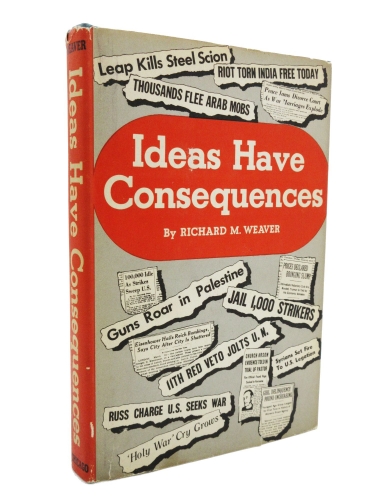


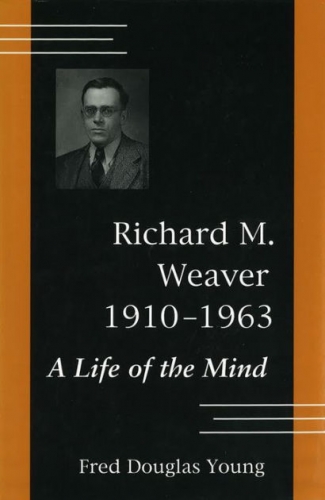

 del.icio.us
del.icio.us
 Digg
Digg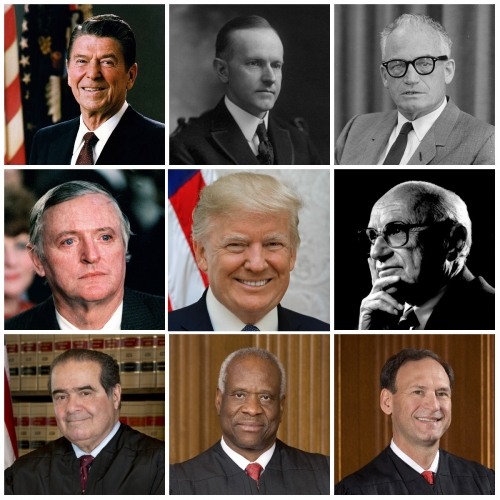
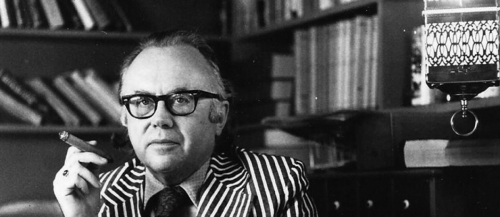
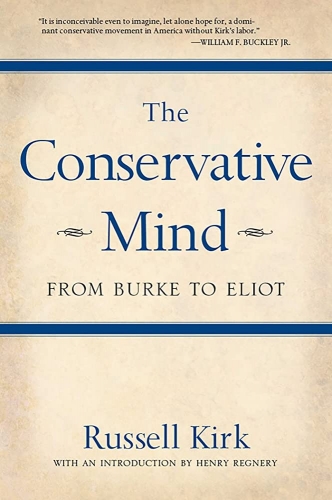

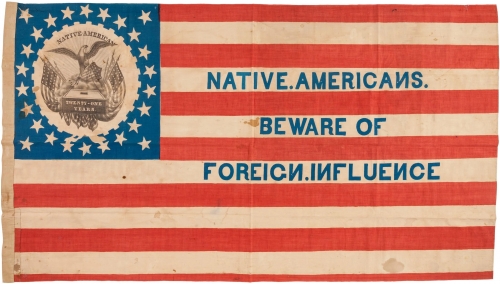
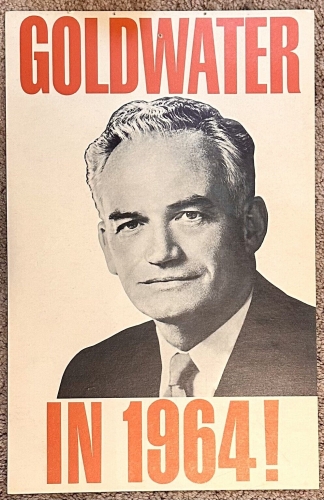
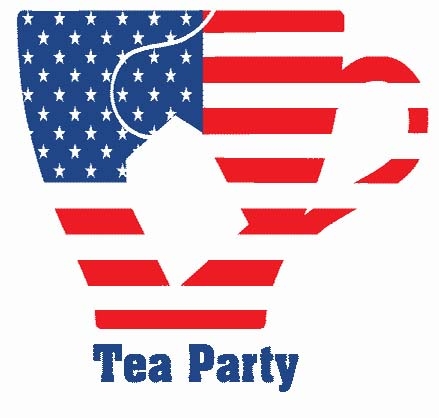
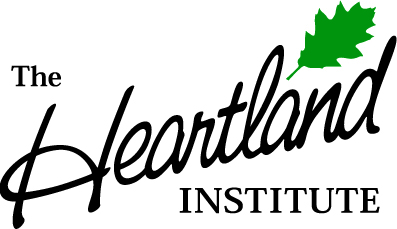

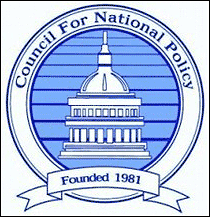
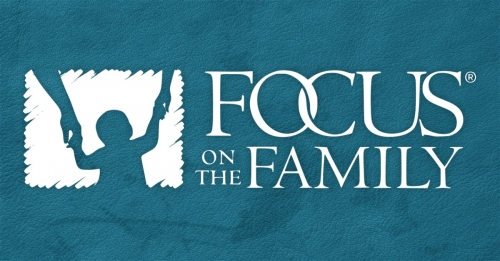


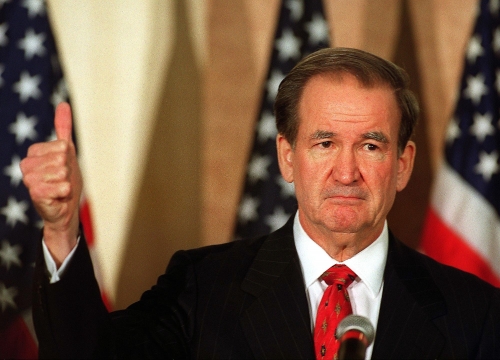
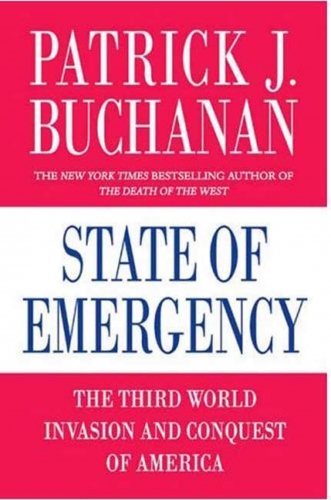
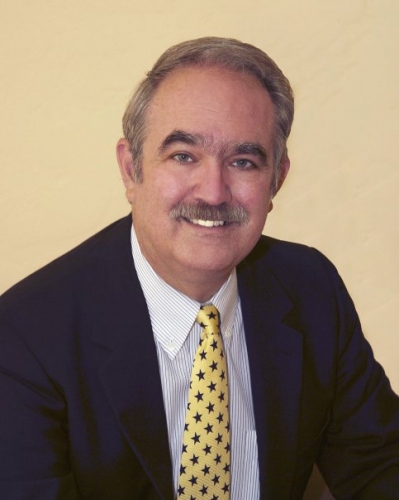

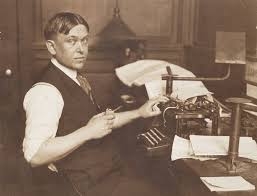
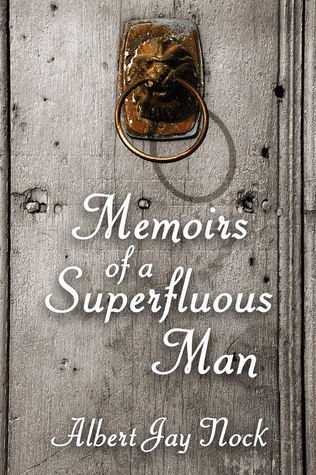 It may be Nock’s “
It may be Nock’s “
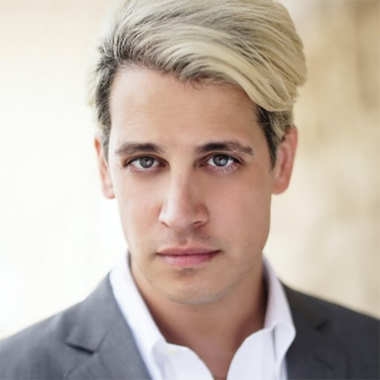 The Alt-Right broadly defined would be anything on the Right that is in opposition to the neocon-led Republican alliance. This could include everything from many Donald Trump voters in the mainstream, to various tendencies that have been given such labels as the “alt-lite,” the new right, the radical right, the populist right, the dark enlightenment, the identitarians, the neo-reactionaries, the manosphere (or “men’s right advocates”), civic nationalists, economic nationalists, Southern nationalists, white nationalists, paleoconservatives, right-wing anarchists, right-leaning libertarians (or “paleolibertarians”), right-wing socialists, neo-monarchists, tendencies among Catholic or Eastern Orthodox traditionalists, neo-pagans, Satanists, adherents of the European New Right, Duginists, Eurasianists, National-Bolsheviks, conspiracy theorists, and, of course, actually self-identified Fascists and National Socialists. I have encountered all of these perspectives and others in Alt-Right circles.
The Alt-Right broadly defined would be anything on the Right that is in opposition to the neocon-led Republican alliance. This could include everything from many Donald Trump voters in the mainstream, to various tendencies that have been given such labels as the “alt-lite,” the new right, the radical right, the populist right, the dark enlightenment, the identitarians, the neo-reactionaries, the manosphere (or “men’s right advocates”), civic nationalists, economic nationalists, Southern nationalists, white nationalists, paleoconservatives, right-wing anarchists, right-leaning libertarians (or “paleolibertarians”), right-wing socialists, neo-monarchists, tendencies among Catholic or Eastern Orthodox traditionalists, neo-pagans, Satanists, adherents of the European New Right, Duginists, Eurasianists, National-Bolsheviks, conspiracy theorists, and, of course, actually self-identified Fascists and National Socialists. I have encountered all of these perspectives and others in Alt-Right circles.
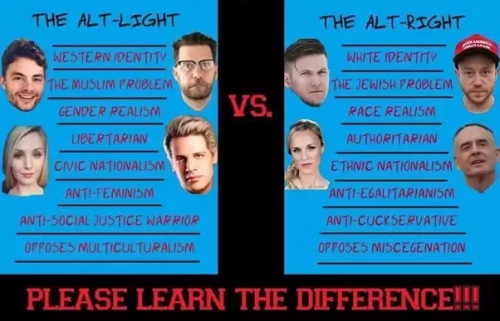
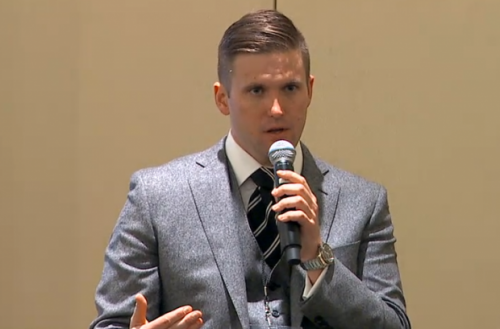
 These comments are fairly representative of the rhetoric used by mainstream conservatives who attempt to either portray the Alt-Right as leftists, or label the Alt-Right as fascists and then claim fascism is really on the Left. The general argument that is made by mainstream conservatives in response to the Alt-Right is that “true” conservatism or the “true” Right is actually veneration for the Enlightenment-influenced ideas found in the Declaration of Independence, veneration of the Founding Fathers, and reverence for the Constitution as a kind of secular Bible. Parallel to these claims is the idea of America as a “propositional nation” that has no roots in any kind of history, culture, or tradition other than just a very vaguely defined “Judeo-Christianity.” This idea of what “conservatism” supposedly is basically amounts to being for so-called “limited government,” so-called “free enterprise,” “individualism,” and various other vaguely defined abstractions, plus policy preferences like a so-called “strong national defense” (which is often just a euphemism for the neoconservatives’ foreign policy agenda), and various center-right policy prescriptions like tax cuts, opposing Obamacare, opposing affirmative action, opposing gun control, opposing abortion, opposing gay marriage, supporting school vouchers, and other ideas we are all familiar with.
These comments are fairly representative of the rhetoric used by mainstream conservatives who attempt to either portray the Alt-Right as leftists, or label the Alt-Right as fascists and then claim fascism is really on the Left. The general argument that is made by mainstream conservatives in response to the Alt-Right is that “true” conservatism or the “true” Right is actually veneration for the Enlightenment-influenced ideas found in the Declaration of Independence, veneration of the Founding Fathers, and reverence for the Constitution as a kind of secular Bible. Parallel to these claims is the idea of America as a “propositional nation” that has no roots in any kind of history, culture, or tradition other than just a very vaguely defined “Judeo-Christianity.” This idea of what “conservatism” supposedly is basically amounts to being for so-called “limited government,” so-called “free enterprise,” “individualism,” and various other vaguely defined abstractions, plus policy preferences like a so-called “strong national defense” (which is often just a euphemism for the neoconservatives’ foreign policy agenda), and various center-right policy prescriptions like tax cuts, opposing Obamacare, opposing affirmative action, opposing gun control, opposing abortion, opposing gay marriage, supporting school vouchers, and other ideas we are all familiar with.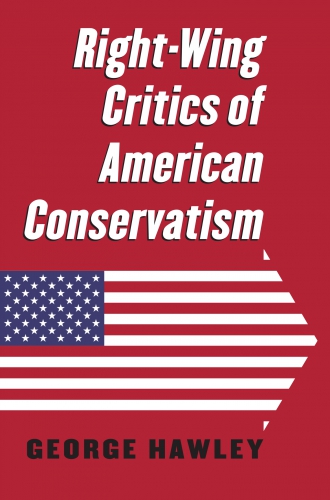
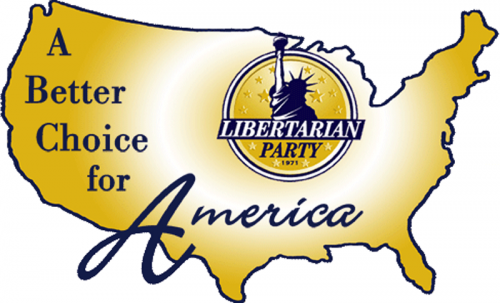

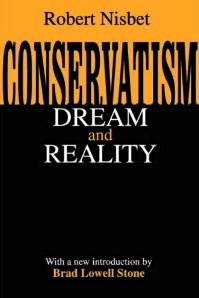 Fourth, there is a common dislike of war and, more especially, of war-society, the kind of society this country knew in 1917 and 1918 under Woodrow Wilson and again under FDR in World War II. Libertarians may protest this, and with some ground. For, the complete libertarian is certainly more likely to resist in overt fashion than is the conservative–for whom respect for nation and for patriotism is likely to be decisive even when it is a war he opposes. Even so, I think there is enough common ground, at least with respect to principle, to put conservatives and libertarians together. And let us remember that beginning with the Spanish-American War, which the conservative McKinley opposed strongly, and coming down through each of the wars this century in which the United States became involved, the principal opposition to American entry came from those elements of the economy and social order which were generally identifiable as conservative-whether “middle western isolationist,” traditional Republican, central European ethnic, small business, or however we wish to designate such opposition. I am certainly not unmindful of the libertarian opposition to war that could come from a Max Eastman and a Eugene Debs and from generally libertarian conscientious objectors in considerable number in both world wars, but the solid and really formidable opposition against American entry came from those closely linked to business, church, local community, family, and traditional morality. (Tocqueville correctly identified this class in America as reluctant to engage in any foreign war because of its predictable impact upon business and commerce chiefly, but other, social and moral activities as well.) This was the element in American life, not the miniscule libertarian element, that both Woodrow Wilson and FDR had to woo, persuade, propagandize, convert and, in some instances, virtually terrorize, in order to pave the way for eventual entry by U.S. military forces in Europe and Asia.
Fourth, there is a common dislike of war and, more especially, of war-society, the kind of society this country knew in 1917 and 1918 under Woodrow Wilson and again under FDR in World War II. Libertarians may protest this, and with some ground. For, the complete libertarian is certainly more likely to resist in overt fashion than is the conservative–for whom respect for nation and for patriotism is likely to be decisive even when it is a war he opposes. Even so, I think there is enough common ground, at least with respect to principle, to put conservatives and libertarians together. And let us remember that beginning with the Spanish-American War, which the conservative McKinley opposed strongly, and coming down through each of the wars this century in which the United States became involved, the principal opposition to American entry came from those elements of the economy and social order which were generally identifiable as conservative-whether “middle western isolationist,” traditional Republican, central European ethnic, small business, or however we wish to designate such opposition. I am certainly not unmindful of the libertarian opposition to war that could come from a Max Eastman and a Eugene Debs and from generally libertarian conscientious objectors in considerable number in both world wars, but the solid and really formidable opposition against American entry came from those closely linked to business, church, local community, family, and traditional morality. (Tocqueville correctly identified this class in America as reluctant to engage in any foreign war because of its predictable impact upon business and commerce chiefly, but other, social and moral activities as well.) This was the element in American life, not the miniscule libertarian element, that both Woodrow Wilson and FDR had to woo, persuade, propagandize, convert and, in some instances, virtually terrorize, in order to pave the way for eventual entry by U.S. military forces in Europe and Asia.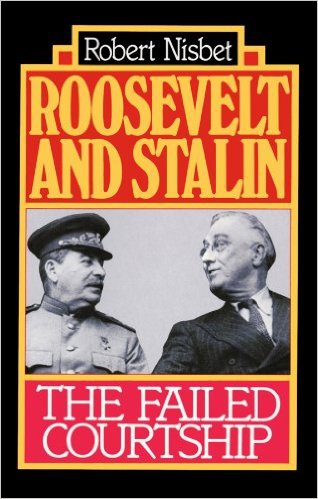 To argue, as some libertarians have, that a solid, strong body of authority in society is incompatible with individual creativity is to ignore or misread cultural history. Think of the great cultural efflorescences of the 5th century B.C. in Athens, of 1st century, Augustan Rome, of the 13th century in Europe, of the Age of Louis XIV, and Elizabethan England. One and all these were ages of social and moral order, powerfully supported by moral codes and political statutes. But the Aeschyluses, Senecas, Roger Bacons, Molieres, and Shakespeares flourished nonetheless. Far from feeling oppressed by the hierarchical authority all around him, Shakespeare–about whose copious individuality there surely cannot be the slightest question–is the author of the memorable passage that begins with “Take but degree away, untune that string, and hark! what discord follows; each thing meets in mere oppugnancy.” As A. L. Rowse has emphasized and documented in detail, the social structure of Shakespeare’s England was not only solid, its authority ever evident, but nothing threw such fear into the people as the thought that authority–especially that designed to repulse foreign enemies and to ferret out traitors–might be made too loose and tenuous. Of course such authority could become too insistent at times, and ingenious ways were found by the dramatists and essayists to outwit the government and its censors. After all, it was strong social and moral authority the creative minds were living under–not the oppressive, political-bureaucratic, limitless invasive, totalitarian governments of the twentieth century.
To argue, as some libertarians have, that a solid, strong body of authority in society is incompatible with individual creativity is to ignore or misread cultural history. Think of the great cultural efflorescences of the 5th century B.C. in Athens, of 1st century, Augustan Rome, of the 13th century in Europe, of the Age of Louis XIV, and Elizabethan England. One and all these were ages of social and moral order, powerfully supported by moral codes and political statutes. But the Aeschyluses, Senecas, Roger Bacons, Molieres, and Shakespeares flourished nonetheless. Far from feeling oppressed by the hierarchical authority all around him, Shakespeare–about whose copious individuality there surely cannot be the slightest question–is the author of the memorable passage that begins with “Take but degree away, untune that string, and hark! what discord follows; each thing meets in mere oppugnancy.” As A. L. Rowse has emphasized and documented in detail, the social structure of Shakespeare’s England was not only solid, its authority ever evident, but nothing threw such fear into the people as the thought that authority–especially that designed to repulse foreign enemies and to ferret out traitors–might be made too loose and tenuous. Of course such authority could become too insistent at times, and ingenious ways were found by the dramatists and essayists to outwit the government and its censors. After all, it was strong social and moral authority the creative minds were living under–not the oppressive, political-bureaucratic, limitless invasive, totalitarian governments of the twentieth century.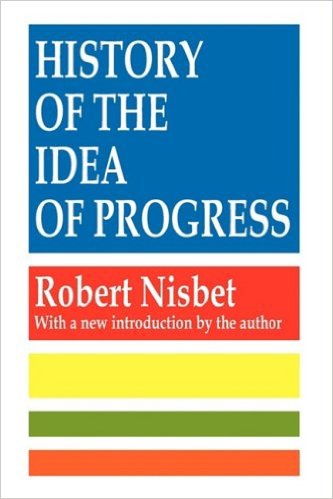 Libertarians, whom I herewith stipulate to be as patriotic and loyal American as any conservatives, do not, in my judgment, see the national and world picture as I have just drawn in. For them the essential picture is not that of a weakened, softened, and endangered nation in a world of Soviet Unions and Chinas and their satellites, but, rather, an American nation swollen from the juices of nationalism, interventionism and militarism that really has little to fear from abroad. Conservatives remain by and large devoted to the smaller patriotisms of family, church, locality, job and voluntary association, but they tend to see these as perishable, as destined to destruction, unless the nation in which they exist can recover a degree of eminence and international authority it has not had since the 1950’s. To libertarians on the other hand, judging from many of their writings and speeches, it is as though the steps necessary to recovery of this eminence and international authority are more dangerous to Americans and their liberties than any aggressive, imperialist totalitarianisms in the world.
Libertarians, whom I herewith stipulate to be as patriotic and loyal American as any conservatives, do not, in my judgment, see the national and world picture as I have just drawn in. For them the essential picture is not that of a weakened, softened, and endangered nation in a world of Soviet Unions and Chinas and their satellites, but, rather, an American nation swollen from the juices of nationalism, interventionism and militarism that really has little to fear from abroad. Conservatives remain by and large devoted to the smaller patriotisms of family, church, locality, job and voluntary association, but they tend to see these as perishable, as destined to destruction, unless the nation in which they exist can recover a degree of eminence and international authority it has not had since the 1950’s. To libertarians on the other hand, judging from many of their writings and speeches, it is as though the steps necessary to recovery of this eminence and international authority are more dangerous to Americans and their liberties than any aggressive, imperialist totalitarianisms in the world.
Paul E. Gottfried
Paul Gottfried has spent the last thirty years writing books and generating hostility among authorized media-approved conservatives. His most recent work is his autobiography Encounters; and he is currently preparing a long study of Leo Strauss and his disciples. His works sell better in Rumanian, Spanish,Russian and German translations than they do in the original English, and particularly in the Beltway. Until his retirement two years hence, he will continue to be Raffensperger Professor of Humanities at Elizabethtown College in Elizabethtown, PA.